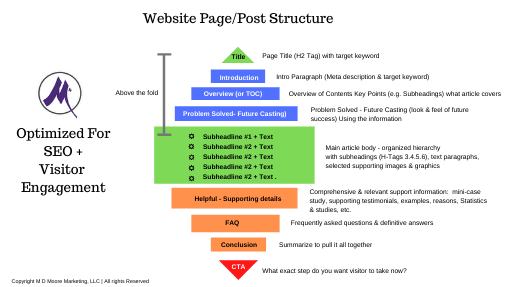Website Content Ideal Blog Post Length Research for Companies Local SEO
Local SEO ranking success in local search traffic can suffer depending on how you are implementing best practices for page ideal blog post length and optimization.
6 Page Length & Optimization Best Practices for 2021
Page and Post content length and optimization directly affect promoting your brand and generate site traffic that can be converted into leads and buyers. Poorly done your brand promotion and website traffic suffers. The 6 recommendation for page length based on our updated 2020 research for local SEO :
- Find content topics that directly answer your target market search interests.
- Write content first for your visitors search query.
- Make sure the length of your draft is at least the minimum for blog type and longer than competitors.
- Once you draft meets length criteria go back and add search engine optimization techniques for ranking.
- Provide the answer to the search query early in your top of page summary.
- Add page engagement techniques like images, videos, charts and graphics to get visitors to read more.
Here’s the Research and Findings updated for 2021 Supporting Content for Local SEO
The question continues to come up about “what is the best length” for website Blog Posts or Core Pages (“page/post”).
The rational surrounding the question of length relates to Search Engine Optimization (SEO) , Visitor Relevance and Content Quality.
Search Engine Optimization (SEO) – Content Length
Search Engine Results Pages (SERP)
SERP’s are the pages displayed by search engines in response to a query by a user. The search engines (Google, Bing, etc.) index all published pages on the internet to determine how high to rank a given website page/post, against all others, when someone searches for answers on the Web.
Simply put, the search engines rank the pages based on how their “algorithms” (coded rules) determine which website pages best answer the search question (called the “search query”) and list them in the SERP..
Website content ranking matters as the most important factor for a local business to build brand recognition and attract Free traffic to their page/post content online. Done right the visitor may become a lead or take a desired action (buy a product/service or book appointment, etc.). To support getting your content ranked we find that the ideal blog post length matters.
If your website page/post shows up (ranks) in the SERP’s on page one among the top 10 for a given search query (or is in the 3-Pack at the top of the search page), you have the opportunity to be noticed and get some of the free Clicks that bring traffic to your website.
The top 10 ranked web pages/posts for a given search term will get the majority of the Clicks. If your not on page one of a search but somewhere on all other pages 2 – 36, you will get very little if any free traffic.
Visitor Relevance Based on Page Content
This basically means that the higher the quality of your page/post content, the more thoroughly your topic is covered and the more engaging the page/post layout (relevant engagement techniques, images, videos, quizzes, graphics, etc.) the better it addresses the visitor’s needs. It is relevant to the search query.
Here are two key outcomes…
- If a user stays on your page longer because it is engaging and helpful the more likely they are to have an interest in your brand and its products/services. They will also have the opportunity to view other related pages on your site if they are staying longer.
- The SEs notice how long someone stays on a page. The longer they stay (reading, scanning, etc.) it leads the SE’s to conclude this page must be providing what the searcher needed…a ” best answer.”Ouch! If the visitor clicks away from a page/post quickly this affects “bounce rate” (clicking away from your website) and this would hurt your page/post ranking. The longer they stay engaged on your page/post the better.
What Does Page/Post Length Have to Do with Ranking for Local Digital Marketing SEO?
There are two main factors for ranking associated with length.
- Google for example tracks how effectively a search query is satisfied and their data shows that length is a factor as it means that people stay on longer page/post articles without clicking away.
- While a lot goes into this, search engines have concluded that longer page/post word counts best satisfy a search query because the page/post topic is deep, complete, and extensive, providing higher value to the search query.
Latest Research on Website Page/Post Length Best Practices
The following excerpts from high authority digital marketing sources are intended to provide a brief overview of the relevant information and data they have studied about on page/post length.
A link is provided below each source if you want to read the entire article.
What percentage of Google searches go past the first page?
To understand the importance of finding the right “length” for website Pages/Posts, the small and mid-size local business needs to understand how ranking for a given search query (question searched) affects the free organic traffic + brand promotion that could be obtained by ranking on the first page.
Forbes (Content Length)
According to Moz, the first page of Google captures 71% of search traffic clicks and has been reported to be as high as 92% in recent years. Second-page results are far from a close second coming in at below 6% of all website clicks. The first five results receive 67.6% of clicks, whereas the remaining five just receive 3.73% https://www.forbes.com/sites/forbesagencycouncil/2017/10/30/the-value-of-search-results-rankings/#1dc07f5644d3
According to SEO Clarity the Top 10 ranked website Pages for a given search term can be expected to get the following percent of the traffic to click to their page.
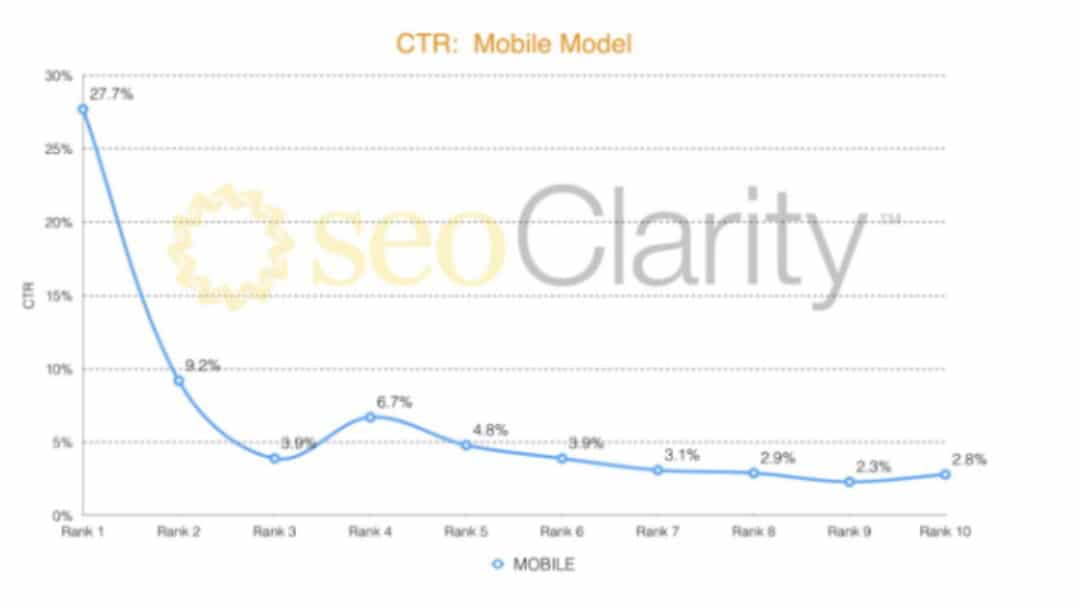
Summary: Since most people today searches on their mobile phone here is what the local business needs to know related to traffic opportunity with local SEO optimization of page content:
| Page Rank | % Traffic Clicks |
| 1 | 19.3% |
| 2 | 11.4% |
| 3 | 7.7% |
| 4 | 5.2% |
| 5 | 4.1% |
| 6 | 3.3% |
| 7 | 2.6% |
| 8 | 2.1% |
| 9 | 2.0% |
| 10 |
2.2%
|
For a local business to Rank in the Top 10 on Page one of a search is important…being in the Top 5 is huge.
Example: If a given local search query gets a total of 500 views in a month on mobile they will get 20 Clicks to their page where they have a chance to capture the lead or convert an action on their website While the number 1 ranked page would get nearly 100 clicks.
Advanced Web Ranking – (updated monthly)
Page rank by Clicks for both Mobile and Desktop
https://www.advancedwebranking.com/ctrstudy/
You will see on the Advanced Web Ranking chart below I placed color over-lays to point out top 5 and top 10 page rank results for clarity.
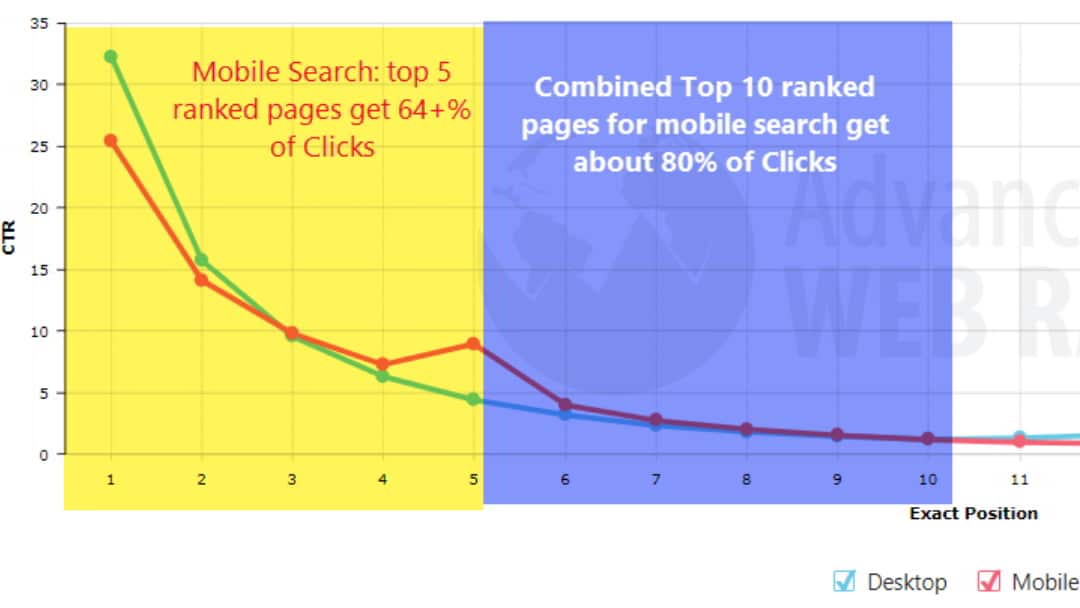
“This chart shows the organic click-through rates for searches coming from 2,899,347 keywords for 59,270 websites.” This is a lot of supporting data for content length and local SEO optimization.
WordStream (Google Comment)
What really matters is how many people are clicking on your listing (and not bouncing back immediately). You want to attract more visitors who are likely to stick around and then convert.
[>>>Finally, right from Google Directly – Matt Cutts @ Google]
“It doesn’t really matter how often you show up. It matters how often you get clicked on and then how often you … convert those to whatever you really want (sales, purchases, subscriptions)…” Read more at Wordstream
Backlinko
1. The average page Google voice search result contains 2,312 words (Backlinko)
2. Roughly 75% of voice search results are from one of the top 3 desktop ranking pages for a given query (Backlinko)
3. Mobile voice searches are 3x more likely be for something local than text searches (Search Engine Watch)
4. By 2020, 50% of all search queries will be voice searches (ComScore) See more on this study at Backlinko Ranking Factors
HubSpot
Ideal Blog Post Length for SEO 2020
For SEO, the ideal blog post length should be 2,100-2,400 words, according to HubSpot data. We averaged the length of our 50 most-read blog posts in 2019, which yielded an average word count of 2,330. Individual blog post lengths ranged from 333 to 5,581 words, with a median length of 2,164 words.
But before you go writing your 2,300 word blog post, keep in mind that not all blog posts need to be super long — in fact, 16 of our top 50 read posts (or about one-third) were under 1,500 words, so there’s still plenty of opportunity to get your posts ranking even with a lower word count. Read the whole study at HubSpot
The HubSpot article breaks down the word count by “Blog Type”. I have summarized this from the article belwo.
By Blog Type:
Pillar Post [a featured article intended to provide extensive and authoritative content]:
“Pillar pages should be around 4,000 words, since they are supposed to cover significantly more content than an average blog post.”
Lead Generation Post:
The 50 posts that generated the most leads in 2019 were an average of 2,569 words long and had a median length of 2,529 words.
So, for a blog post intended to build your contact database, writing longer content definitely works in your favor. Longer content reinforces your knowledge and authority on a subject”
List Posts [numbered, bullet point based]:
Listicles, or list blog posts, should be 2,300-2,600 words. List blog posts are probably the most approachable blog post format for new bloggers

Source: https://www.quicksprout.com/website-design-best-practices/
“How To” Type Post Length
How-to blog posts should be between 1,700 and 2,100 words.
Because how-to posts describe, well, how to do something, the ideal length of the blog post depends on how difficult it is to do what you’re explaining how to do.
[Note: how to posts are very popular in many cases and are a key part of local digital marketing]“What Is” Post:
“What is” posts, or blog posts that answer a question (such as the one you’re reading right now), should be between 1,300 and 1,700 words (which this one is!).
Backlinko (Brian Dean) [one of the most respected sources on page/post attributes]
According to a study conducted by Backlinko in September of 2016, the average word count of blog posts already ranked on Google’s first page was 1890.
Not much has change over all in 2020.
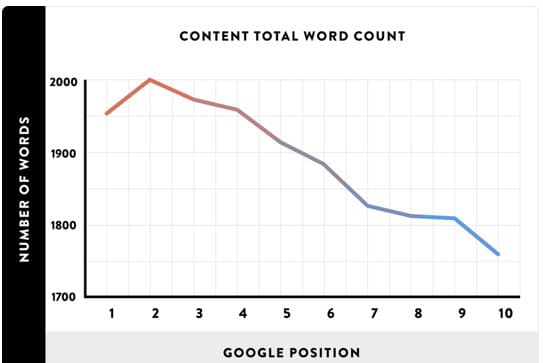
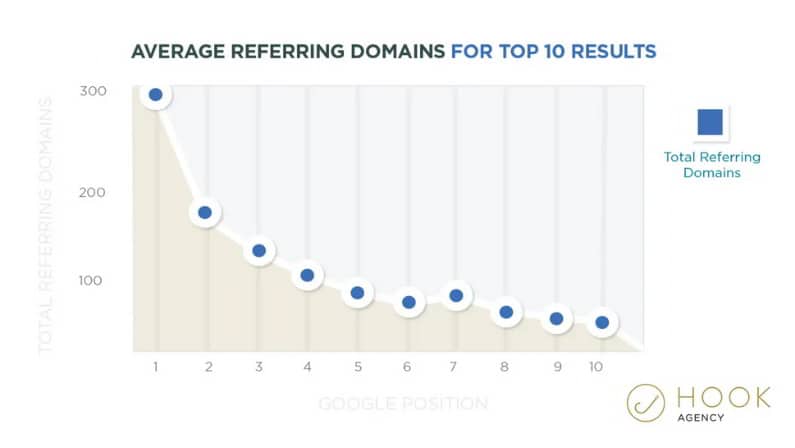
Buffer
SerpIQ examined the question of ideal post length from an SEO perspective. They looked at the top 10 results on search results pages and counted the words in each article. Their data included text in the [page] sidebars of posts, so you can knock a few words off the totals below. See the complete article at Buffer
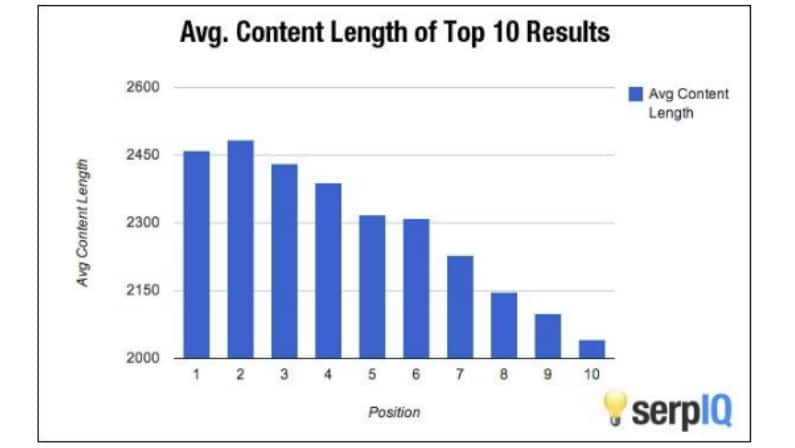
Medium | Related to Local SEO As Well
The ideal length of a blog post is 7 minutes, about 1,600 words
When measuring the content that performs best on their site, Medium focuses not on clicks but on attention. How long do readers stick with an article?
In this sense, an ideal blog post would be one that people read. And Medium’s research on this front says that the ideal blog post is seven minutes long.
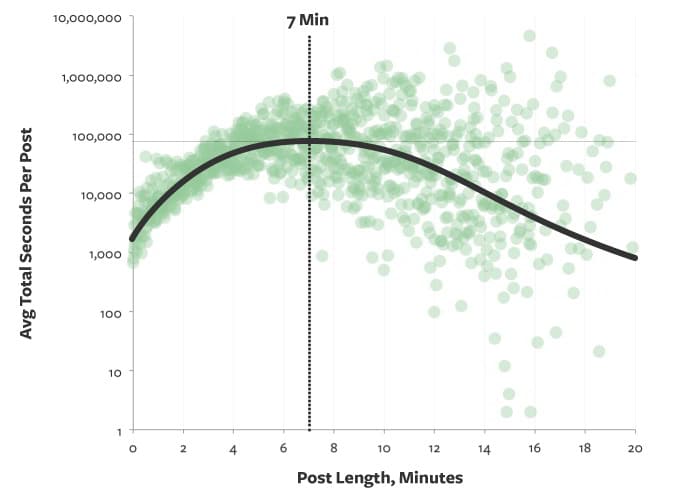
Search Engine Journal
Longer Blog Posts Get More Backlinks
The term “back links” refers to the number of other Websites who link back to your website pages/posts. Back links from high ranked authority websites are an important ranking boost factor in the SEs.
In 2019, (Brian) Dean and BuzzSumo reviewed 912 million blog posts and discovered that long-form content gets more backlinks, the number 1 ranking factor according to the study from 2016! Read more at SEJ
“Long-form content gets an average of 77.2% more links than short articles. Therefore, long-form content appears to be ideal for backlink acquisition.”
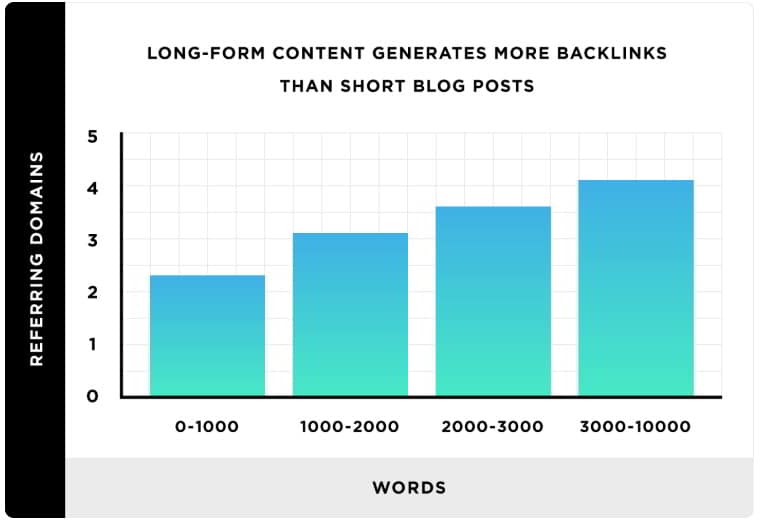
ContentFly
https://contentfly.co/blog/blog-writing-trends-of-2020/
“Long Form Content is King”
The idea that the optimal length of blog posts should be around 1,000-words long is dying out.
Instead, long form, information-packed articles spanning between 1,000 – 7,000 words long are becoming popular due to the high rate of traffic they attract. In fact, blog posts that are over 3,000 words in length tend to receive the most internet traffic.”
- Writers often lack the ability to keep readers fully engaged. Most of us aren’t great writers.
- Better content often requires stronger writers–which come at a premium price [if you outsource it] or comprehensive training and experience to create on your own.
- One of the main issues that bloggers encounter when creating longer posts is keeping readers fully engaged. Studies by Nielsen Norman Group determined that the average user will read 20 – 28% of the words [on a page/post) More here at nngroup
Note: Writing long articles is hard. That said, my experience at M4 is that the owners of small and mid-size local companies really know their products or services inside out, and they have a great feel for their customers needs, wants and questions. Given some training and templates to follow they can create great website content that is real and believable for local digital marketing..
Lifewire
Scrolling Isn’t the Only Thing That Hides Information
The most common argument against writing long pages is that readers may never even see it. But putting that information on another page altogether hides it even more effectively (e.g. breaking a long article into 2 – 3 shorter posts).
Multi-page articles see a drop off of around 50 percent for every page after the first one. In other words, if 100 people hit the first page of an article, 50 make it to the second page, 25 to the third, and 10 to the fourth, and so on.
And in fact, the drop off is much more severe after the second page (something like 85 percent of the original readers never make it to the third page of an article). Read more at Lifewire – Page Length
NOTE: It is Important to remember the two factors about length: will it rank higher by SEs and will it add value and engagement to the reader. A shorter page/post may be read more often …but will it be ranked higher by SEs against competing pages/posts and will those wanting more comprehensive detail be satisfied? The answer is most often No.
M4 Digital Marketing Local SEO Conclusions & Recommendations
In 2020 it is true that our website visitors like shorter posts…people are busy and active. So in general people tend to scan.
But this is a bit of a trap and an easy place to hide behind.
People scan because the want to quickly find the information that answers their search query.
But when they find the answer with valuable additional information, videos, graphs, data, quizzes, expert curation that provides complete and relevant explanations…they engage with it.
They get a “best answer” they feel is value added, unexpected, that helps them understand the whole picture and the means to take action and use the new knowledge, stay on the page , engage with the content and the SEs notice and your ranks improves. , so make it feel like it’s short by how you structure content. So again, the use of ideal blog post length is a ranking factor local companies should embrace.
Here is how I see it. “Great engaging website content is Not good because it’s Long…it’s Long Because its good!”
The M4 recommended strategy, supported by current research, and it’s achievable:
- Find content topics in your target market that answer the questions, needs and desires of the people you want as customers.
- Write first with the Visitor in mind (or hire someone to write it). Meet their needs and search query with quality, well researched information. Write your outline with comprehensive thoroughness.
- Check the length of the initial draft and make sure it meets two criteria for word count.
- It is at least minimum length for the type of Article you are creating (see M4 chart at top of this page).
- But in all cases, make sure it is longer than your competitors’ content on the specific search query subject by at least 20% (don’t make it easy for them to out rank you).
- Last, with your page/post draft meeting the criteria above, then and only then, optimize for the Visitors who scan and the search engines who rank with search engine optimization (SEO).
- Give visitors the best direct answer early in the article (above the fold). Provide a “summary” or short answer(s) and then employ “engagement techniques” to motivate them to read more.
- Optimize the final draft for Search Engine ranking purposes, using proven SEO techniques (content structure, schema markup, and many more).
The important point is that you can create your post/page content so it can be scanned quickly by how you structure it (make pages/posts feel shorter) but still give Google the length it loves by using search query related keywords for scannable headings and bullet points.
They get quick answers and an invitation to learn a whole lot more by continuing to read your comprehensive and interesting quality in depth information, videos, authority curation quotes…and so much more.
Check out this 3,600 word website Post to see a best-practice layout for making a long article readable, scannable and engaging>>> Ads Triangle Blog SEO Best Practices https://www.adstriangle.com/blog/seo-best-practices/
That becomes the long and short of great website content!
Conclusion | How Do You Accomplish this Winning Strategy?
Read more below and really get the direction you need to create terrific, competitor beating, Page/Post articles that get you ranked.
- Aim for more backlinks from high authority/expert websites to boost your ranking.
- Create articles top of page section by a direct and focused Introduction & Summary that clearly answers the visitors search query better than your competitors. Make it brief, crystal clear and concise best answer.
- Next, lead into main article by proposing the “problem solved by your article and then encourages and engages visitors to stay on the page continuing to read your valuable article details.
- Provide more comprehensive and subject broadening details after your main article body for both the intense interested readers and for SE ranking.
- Pinpoint the top 1 – 3 most frequently asked questions that relate directly to the visitors search query and provide succinct and clear answers.
- Finish with your short “conclusion” that brings it all together and add your CTA to direct the visitors next action.
More Related Resources: 8 Steps For Local Business Digital Marketing
